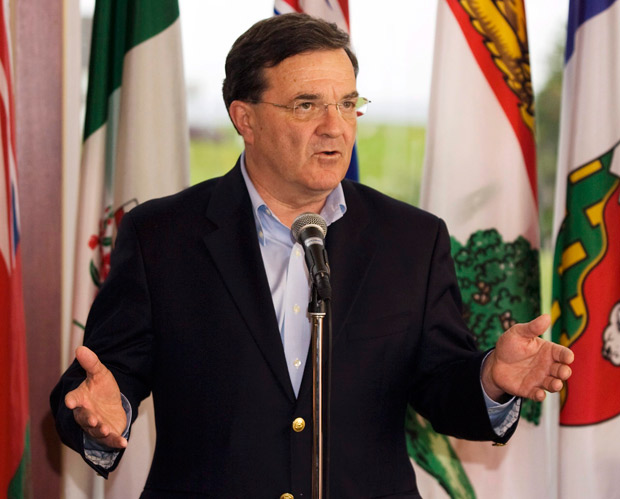REGINA, Sask. – The province that introduced medicare and public auto insurance to Canada could soon be leading the way in pension reform.
The Saskatchewan Pension Plan, which has been around since 1986, may well be the model for the pooled pension plans that the country’s finance ministers proposed last week in Kananaskis, Alta.
The federal and provincial finance ministers agreed to introduce legislation to allow the creation of pooled registered pension plans (PRPPs), targeted to employees of small-and medium-sized businesses.
The PRPPs would be "low-cost" private pension plans that would be available to employees without a company pension plan or even an employer, in the case of self-employed people. Employee participation would be mandatory, unless the employee opted out of the plan.
The closest thing we have to a PRPP in Canada today is the Saskatchewan Pension Plan (SPP), a voluntary pension plan to which employees, self-employed individuals and/or their spouses can contribute up to $2,500 annually.
Originally designed for homemakers or self-employed people without access to a pension plan, in less than 25 years, the SPP has grown to more than $268 million in assets and 31,000 members.
"We’re the 26th-largest defined-contribution pension plan in Canada," said Kathy Strutt, general manager of the SPP.
"We don’t have the billions that the public employees pension plan or the co-op superannuation plan have. We’re small compared to other government plans, but we’re not small when you look at the DC (defined-contribution pension) world."
Not bad for a pension plan based in Kindersley, Sask., where the SPP was relocated in 1990, with no sales force and, until recently, a $600 annual contribution limit.
Strutt said the changes announced earlier this month should help increase the profile and public participation in the SPP, which was developed and introduced by the Progressive Conservative provincial government of former premier Grant Devine.
With the contribution limit increased to $2,500 per year, participants could potentially save $100,000 over 30 years, based on an average six per cent rate of return, she said.
Dave Wild, chairman of the Saskatchewan Financial Services Commission, participated in the discussions in Kananaskis between the federal government and other provinces on the issue of PRPPs. He agrees that the SPP could be the model for the rollout of PRPPs across Canada.
"I think the SPP was heavily influential in developing the framework for the pooled (registered pension plan) arrangements," said Wild, who is also the province’s superintendent of pensions.
Since June, Wild has been involved in a working group on "pension innovation" to demonstrate how pooled pension plans, similar to the SPP, could provide benefits to individuals without a company pension.
"(The) Saskatchewan Pension Plan is broad-based," Wild said. "Any employer and any employee can participate."
The SPP can cover employees of small- and medium-sized businesses or self-employed individuals, who otherwise wouldn’t have a company pension. "The SPP was developed to serve a niche that was not being well-served by the pension industry."
There are differences between pooled pension plans and the SPP, Wild added. Pooled plans would tend to be privately-operated by insurance companies, mutual fund managers, banks and other financial institutions, while the SPP is a public-sector, non-profit organization operating at arm’s-length from government.
"They left the door open to other third-party administrators, which is where the SPP would fit in. But I don’t think the finance ministers had a particular model in mind that was government-administered," Wild added.
Not everyone is convinced that PRPPs are the answer to the Canada’s pension problems, however.
Deputy Liberal leader Ralph Goodale said the concept of PRPPs is fine as far as it goes, but reform of the Canada Pension Plan (CPP) is still required.
"(PRPPs) provide a relatively small portion of the solution . . . There are several other things that are bigger and more important," the former federal finance minister said last week. "Certainly, expansion of the CPP is the core piece."
Goodale note the former Liberal federal government modified the CPP in 1997 with changes to contribution limits and investment management functions, with the creation of the CPP Investment Board. But he said more changes are needed to bring CPP benefits in line with pensioners’ current and future income needs.
While the CPP is actuarially sound and well-managed, most experts agree the CPP should be expanded, by raising the yearly maximum pension earnings (YMPE) to $60,000 or $70,000, or increasing the income replacement rate to 30 or 35 per cent from 25 per cent.
Currently, the maximum payout from the CPP is about $11,800 per year, which is roughly one-quarter of the average industrial wage of $48,000.
But even an expanded CPP would still need to have supplemental plans, like PRPPs and the SPP, that fill the cracks in the system. And the pooled pension plans provided a way forward for the finance ministers on pension reform, where the proposed CPP reforms did not.
"I really don’t know where CPP reform will go," Wild said. "It’s a bigger step (to reform the CPP) in that it’s a mandatory program. (With) the pooled pension arrangements, there will be an encouragement of participation, but certainly, it’s not a requirement. No one can opt out of the Canada Pension Plan."
"The pooled pension arrangement is more flexible, which I think is what allowed ministers to move forward on it, where they want to move a little more cautiously on CPP reform. It’s a more serious decision, a complicated decision."
Wild said the pooled pension plans also offer a lower cost alternative to CPP reform or private investment plans. "There will (be) some interesting discussion around how we encourage low-cost pooled arrangements," Wild said.
"SPP is clearly a low-cost alternative in Saskatchewan. Whether the insurance industry or mutual fund industry will offer similar low-cost products is a point of debate."




Comments